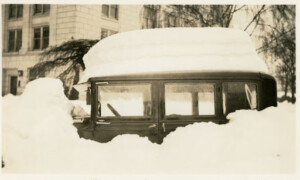Salem Receives Record 27 Inches of Snow: January 31, 1937
“Yes, This is Salem,” read the caption of a front page photo in the Capital Journal on February 1, 1937. During an eighteen-hour stretch the previous day, the City of Salem had received 27 inches of snow–one of the heaviest snows Salem has ever seen.

1937, Taken near 12th Street looking Southwest, Supreme Court Bidg. at rear. 1928 Chevrolet caught in the February 1937 snow storm. Winter of 1936 – 1937, Salem, Oregon, WHC Collections 1986.057.0005
That December had been a cold one for the City; snow earlier in the month had brought relief from a cold snap which saw daytime temperatures in the City at seven degrees above zero. Floating ice on the Willamette River had caused problems for river traffic. The warming trend had been brief, however, and after only two days the mercury again plunged, this time to six degrees. Still, the snow had been minimal, and there had been nothing like the paralyzing snowfall the city experienced on January 31.
All over the City, the deep snow caused problems. Hundreds of cars were stranded on Salem streets, buried in the snow–and then lost completely as the big diesel shovel began clearing snow from the streets, piling it in the gutters. City buses were stuck in the snow. Court hearings were delayed and the postmaster announced that mail would be delivered only to those who shoveled their walks. The roof of the Christian Missionary Alliance Tabernacle on Ferry Street collapsed under the weight of the snow, and all over downtown, building marquees, overburdened by the snow, came crashing down: Miller Mercantile at Liberty and Court Streets, and the Schreder-Berg grocery at State and Commercial Streets among them. Several buildings at the State Fairgrounds were damaged by snow. Jensen’s Greenhouse, a 22,000 square foot structure at 15th and Market Streets, crumbled under the snow, a loss of $15,000. The Dreamland rink at the end of State Street fell “with such force,” according to the Capital Journal, that “shingles were hurled across the street.”
When the prison annex, cottage farm and tuberculosis hospital lost electricity, Portland General Electric workers on skis were sent to find the break in the line. A County grader operator clearing snow from streets was badly injured when he was struck by a train at 12th and Chemeketa; the grader was a total loss.
Hotels overflowed with stranded travelers and people who couldn’t get rooms slept in lobbies. A minor milk shortage developed, with supplies low and almost undeliverable through the snow. A fire at the Marion County Courthouse found Fire Department equipment unable to get to the scene. Fortunately the fire was extinguishable by hand, and damages proved minimal. However, it took nearly two hours to get the fire equipment back to the station. A shortage of hand shovels in the City made the already gargantuan task of clearing sidewalks nearly impossible. With unemployment still high as a result of the Depression, all men desiring work were urged by employment officials to secure shovels and create their own jobs. Snow cleared from roads and sidewalks was dumped into the Willamette River.
To the relief of many, the snow did not linger: on February 1, rain began to fall, beginning the long, slow melting of the snow. The melting was so gradual that flood danger, always a concern in such situations, was averted.
Compiled and written by Kathleen Carlson Clements
Bibliography:
Taylor, George and Raymond R. Hatton. The Oregon Weather Book: A State of Extremes. Corvallis: Oregon State University, 1999.
Capital Journal, January 31-February 3, 1937
This article originally appeared on the original Salem Online History site and has not been updated since 2006.







Leave A Comment